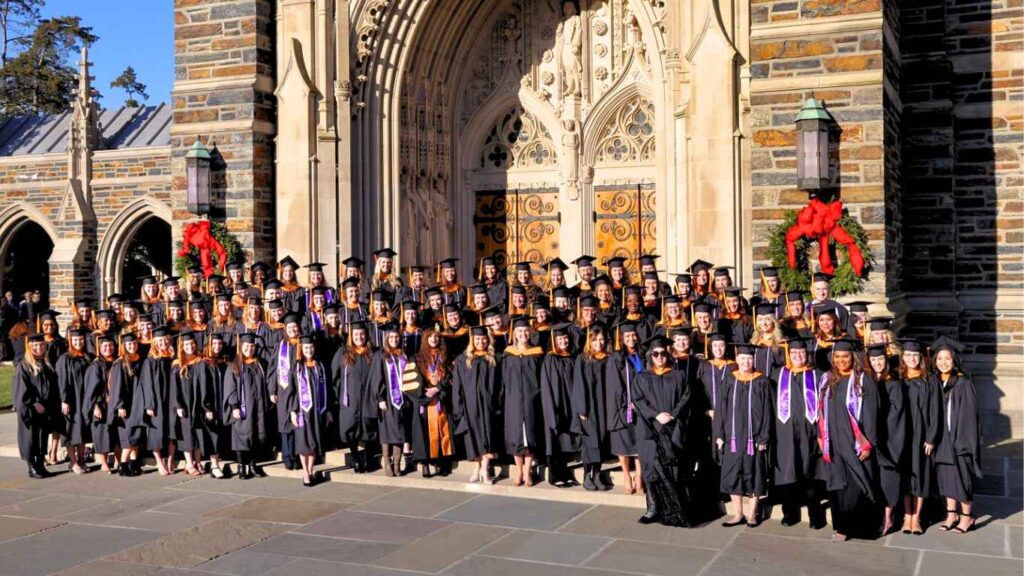Are you considering a career in nursing and looking for the top nursing schools in the US? You’ve come to the right place!
In this blog, we’ll be sharing the top 10 nursing schools in the US. These nursing schools have proven to be the best in the country. Also, they offer an excellent foundation for those looking to enter nursing.
We’ll also provide an overview of each school to help you make an informed decision when selecting the right program.
So, let’s get started!
Leading the Way: Top 10 Nursing Schools in the USA for Aspiring Nurses

Nursing is an important field that is in high demand today. That’s why it’s essential to consider the best nursing schools in the USA.
Here are the top 10 nursing schools in the United States:
University of Pennsylvania School of Nursing

The University of Pennsylvania School of Nursing, is a renowned educational institution that consistently ranks among the top nursing schools in the USA. Undergraduate and graduate degrees are available at the college, allowing students to customize their education.
With its rich history, strong faculty, and state-of-the-art facilities, it is no surprise that UPenn School of Nursing is considered one of the best in the country.
With a commitment to social justice, the University of Pennsylvania School of Nursing strives to ensure all students receive an excellent education.
Johns Hopkins University School of Nursing

Located in Baltimore, Maryland, Johns Hopkins University School of Nursing is one of the top nursing schools in the USA. Established in 1889, the school offers a wide range of degree programs, from undergraduate to doctoral.
With cutting-edge facilities and research opportunities, students can take advantage of a rigorous and comprehensive education.
Also, the university has strong partnerships with leading healthcare providers, allowing students to gain real-world experience.
Duke University School of Nursing

Ranked 3rd among the best nursing schools in the USA, Duke University’s School of Nursing is known for its rigorous and cutting-edge programs. The school prides itself on offering a comprehensive curriculum that challenges and educates students.
Its faculty members are experienced experts in their field. They have been recognized as some of the most knowledgeable in the industry.
With state-of-the-art facilities and top-notch instruction, Duke is an ideal choice for aspiring nurses who want to take their education to the next level.
University of Michigan School of Nursing

The University of Michigan School of Nursing is renowned for its excellence in educating and producing world-class nurses.
Its faculty has consistently ranked among the best in the country, providing students with a rigorous, cutting-edge education. From classroom learning to clinical internships, the school offers an exceptional and diverse learning experience that prepares students to become successful nurses.
With such an outstanding reputation, it’s no wonder why U of M is one of the top nursing schools in the USA for aspiring nurses.
Vanderbilt University School of Nursing

Vanderbilt’s School of Nursing is one of the premier nursing schools in the country.
This university offers a comprehensive curriculum and top-notch faculty. With an emphasis on evidence-based practice, and leadership, Vanderbilt provides students with the skills necessary to succeed in their nursing careers.
Also, the school offers specializations in areas such as family health, adult care, psychiatric mental health, and pediatric nursing.
University of North Carolina at Chapel Hill School of Nursing

The University of North Carolina at Chapel Hill is an excellent choice for aspiring nurses. The school provides comprehensive nursing education with its top-notch faculty and modern facilities.
The School of Nursing offers flexible learning options such as online courses and hybrid programs. These programs allow students to pursue their career goals on their terms.
With its diverse and vibrant campus life, UNC-Chapel Hill is an excellent choice for those looking for a quality nursing education.
Emory University Nell Hodgson Woodruff School of Nursing

Located in Atlanta, Georgia, Emory University’s Nell Hodgson Woodruff School of Nursing is one of the premier nursing schools in the country. Offering a wide range of undergraduate and graduate degree programs, this school prepares students to become leaders in the nursing field.
With top-notch faculty, cutting-edge technology, and innovative clinical experiences, students are well-prepared to practice nursing at the highest level.
Also, the school offers valuable research opportunities for its students.
Indiana University Bloomington School of Nursing

Ranked 10th among the top nursing schools in the USA, Indiana University Bloomington School of Nursing is one of the best options for aspiring nurses.
The school offers a variety of specialized areas, such as acute care, ambulatory care, gerontology, neonatal care, mental health, and more.
Additionally, students benefit from access to the university’s world-class library resources.
Ohio State University College of Nursing

The Ohio State University College of Nursing is a top-notch institution for aspiring nurses. The college offers a range of degrees, including BSN, MSN, DNP, and Ph.D. Also, the college provides various experiential learning opportunities and clinical rotations at its affiliated hospitals and clinics.
With cutting-edge technology and an experienced faculty, Ohio State is an excellent choice for anyone pursuing a career in nursing.
University of Colorado Denver College of Nursing

The University of Colorado, Denver College of Nursing, is an excellent choice for aspiring nurses. With a long history of excellence and an innovative curriculum, students at this college can expect a top-notch education.
Students will benefit from faculty and staff with expertise in research, clinical practice, leadership, and access to advanced technology. Also, the college offers ample opportunities to be involved in the local community, providing hands-on experience.
Conclusion
Aspiring nurses have a lot of options when it comes to choosing a nursing school. With so many excellent schools in the USA, picking the best one for you cannot be easy.
However, with the help of this list of the top 10 nursing schools in the USA, you can make an informed decision about which one is the right fit for you.
Good luck on your journey to becoming a nurse!



![Why Online Clinical Psychology PhD Programs Are Better in 2025 [APA-Accredited]](https://consumersweek.com/wp-content/uploads/2025/06/Why-Online-Clinical-Psychology-PhD-Programs-Are-Better-in-2025-APA-Accredited-870x570.webp)










![No Win No Fee Lawyers: The Hidden Truth About Settlement Cuts Legal representation through no win no fee lawyers gives clients a way to fight cases without paying anything upfront. Many clients don't know that these services take a big chunk of money after winning the case. Lawyers usually take 25% to 40% of what you win as their contingency fee. The amount lawyers take from settlements can add up fast. A $100,000 settlement means your attorney gets $30,000 if they charge a 30% fee after winning your case. Your solicitor's cut might be £10,000 from a £30,000 compensation award, based on your agreement percentage. This payment model stays pretty much the same for no win no fee lawyers in different places, though percentages can change. This piece breaks down what you need to know about contingency fee deals. You'll learn about standard fee ranges, extra costs beyond the basic fee, and times when this payment setup might not work in your favor. Smart clients should think over these money matters before signing up with a lawyer to make better choices about their legal help. What No-Win No-Fee Really Means Image Source: Express Legal Funding A no-win no-fee arrangement, also called a Conditional Fee Agreement, changes the way people get legal help. This payment approach removes the need to pay legal fees upfront and creates a partnership between clients and their attorneys. How contingency fees work No-win no-fee agreements are based on contingency fees. Lawyers get paid only when they win compensation for their clients. Most lawyers take between 25% and 40% of the final amount, based on how complex the case is and where it's filed. Lawyers take their cut after winning the case. To name just one example, see a case where a lawyer wins £30,000 in compensation with a 33% fee - they would receive £10,000. On top of that, some law firms use sliding scales where they charge less for quick settlements and more if the case goes to trial. The law requires a written agreement before any work starts. This paperwork spells out the lawyer's percentage, what costs you'll need to cover, and other key details. What happens if you lose the case The meaning behind "no-win no-fee" is clear - losing your case means you won't pay your lawyer anything. All the same, you should know about a few money-related details. You won't owe your lawyer when you lose, but some deals might make you pay for court fees, expert witnesses, or other case expenses. The other side could also ask you to pay their legal costs. Many lawyers suggest getting "After Event" insurance to protect their clients. These policies cover any costs if you lose your case, which makes the no-win no-fee setup much safer. Why lawyers offer this model Lawyers want to make legal help available to more people, so they offer these payment plans. This setup helps people who don't have much money take legal action when they have valid claims. The payment structure motivates lawyers to work hard. They only get paid by winning cases, which pushes them to get the best results possible. Lawyers carefully assess each case before taking it on a no-win no-fee basis. They usually accept cases that have a good chance of winning, since they put in lots of time and resources without any guaranteed payment. The Real Cost: How Much Do Lawyers Take from a Settlement Image Source: Greiner Law Corp. The true cost of no-win no-fee legal representation becomes clear once we look at contingency fees. Many clients feel surprised to see a big chunk of their settlement checks going to their attorney's fees. Typical percentage ranges (25%–40%) No win no fee lawyers typically ask for 25% to 40% of the total settlement amount. Personal injury attorneys usually take 33.3% (one-third) of the awarded compensation[101]. Lawyers and clients agree on this percentage before any work starts on the case. Several factors shape the final percentage. Your chances of winning, case complexity, and the work to be done play key roles in determining the attorney's cut. Some areas have laws that cap the maximum contingency fees for specific types of cases. Sliding scale based on case complexity Law firms often use a tiered fee system that changes with the case stage and complexity. This scale rewards quick settlements while paying attorneys fairly if more work becomes needed. The fee might start at 30% if the case settles before lawsuit filing. This number could climb to 35% after filing or reach 40% if the case goes to trial. Law firms often group cases by complexity: 10%-20%: Simple cases with straightforward settlements 25%-35%: Typical personal injury cases 35% and above: Complex cases requiring extensive resources Examples of payout breakdowns These ground examples show how fees affect settlements: A $15,000 settlement with a 33.3% contingency fee.pdf) puts $5,000 in the attorney's pocket, leaving $10,000 for the client. Similarly, from a $100,000 settlement with a 33% fee, the attorney gets $33,000 while the client receives $67,000[102]. Complex cases tell a different story. A $100,000 settlement with a 30% fee plus $5,000 in extra costs leaves $65,000 for the client after all deductions. These fees substantially change the client's final payout. Hidden Costs You Might Not Expect Image Source: Nelson Personal Injury Lawyers Beyond percentage-based fees, clients often feel surprised by extra costs that can reduce their final compensation by a lot. These hidden costs show up in the fine print of no-win no-fee agreements. You should think over these details before signing. Court filing and expert witness fees Legal proceedings come with unavoidable court filing fees. These charges differ by jurisdiction. They usually range from $30 for small claims to several hundred dollars for complex civil lawsuits. Expert witnesses can be expensive, with hourly rates ranging from $150 to $1,000 based on their credentials and testimony complexity. Expert witnesses charge more for court appearances than consultation work because of added pressure and prep time. Clients might still need to pay experts for their prep work even if the case settles before trial. Medical report and investigation costs Medical documentation is a vital part of many legal claims. These costs include fees to release medical records, create specialized reports, and prepare documents. Investigation costs cover evidence gathering, police reports, witness interviews, and other fact-finding work needed to build a strong case. Of course, some firms say they'll cover these expenses upfront, but clients don't completely avoid these costs. When these costs are deducted from your compensation Law firms take these expenses from the settlement amount before they calculate their percentage fee, though each firm handles this differently. Some lawyers subtract these costs after figuring out their contingency fee, which changes how much money clients end up with. Most firms pay case-related costs during the process and get their money back from the settlement. The defendant usually pays most simple legal costs and disbursements in successful cases, but not always everything. Insurance protects clients from costs in unsuccessful claims at many law firms, but this protection isn't guaranteed. Clients should review their agreements carefully since they might still need to pay specific expenses even if they lose their case. When No-Win No-Fee Might Not Be the Best Option Contingency fee arrangements give many people access to justice. However, this payment model doesn't always work in a client's best interests. Knowing these limitations helps clients make better decisions about their legal representation. Cases with unclear liability Lawyer no win no fee arrangements work best in cases where fault is clear. We assessed the probability of success before taking contingency cases. Lawyers might turn down cases if there isn't enough evidence of the other party's negligence or if liability isn't certain. Cases with multiple responsible parties create more challenges. The situation gets complicated fast when several parties share liability. Lawyers are less likely to take these cases on contingency. They need to be confident they can prove the other party's negligence before accepting a case. Low-damage or low-payout claims Small claims often don't work well with the contingency model, even with real injuries. Cases that have minimal injuries or limited financial damages might not bring enough compensation to cover legal costs. The potential settlement needs to be big enough to pay for investigations, witness interviews and court fees. Personal injury lawyers often turn down cases where the "compensation potential" is too small. This doesn't mean the claim isn't valid - it just means the economics don't add up for a contingency arrangement. Situations where hourly billing may be better Hourly billing has clear advantages in certain cases. Clients see exactly what they're paying for - every hour worked and task completed. This model works well for cases that need lots of attention but don't have clear financial outcomes. Complex litigation with opposing parties works better with hourly billing and a retainer fee. Clients have more control over their case and don't feel pressured to settle quickly. Cases that need extensive preparation but have uncertain outcomes fit the hourly model better. Lawyers can spend the time needed without worrying about contingency limits. This approach often leads to better representation, especially for complex legal issues that need special expertise. Conclusion Understanding the Full Picture Before You Sign No-win no-fee arrangements offer legal representation without upfront costs. Of course, this seems attractive at first glance. In spite of that, you need to think about how these agreements can affect your final compensation. Legal fees usually range from 25% to 40% of your settlement - but that's just the start. You'll face more deductions like court filing fees, expert witness costs, and charges for medical documentation. What looks like a "free" service ends up taking a big chunk of your compensation to cover legal expenses. These arrangements work best in specific situations - cases with obvious liability, substantial damages, and solid evidence. If you have a low-value claim or complex liability issues, traditional hourly billing might serve you better. Without doubt, you should ask for clear explanations of all possible costs before signing anything. Read the fine print closely, especially when you have to deal with expenses in unsuccessful cases. Ask to see sample settlement breakdowns that show all deductions. This helps you picture what you might actually take home. Your choice to go with a no-win no-fee arrangement depends on your situation. This model helps if you don't have money to pursue valid claims. But if you have a strong case and enough funds, other fee structures might let you keep more of your compensation. Whatever payment model you choose, knowing exactly how much lawyers take from settlements helps you make better decisions. This knowledge lets you approach legal representation with real expectations and better control over your money. FAQs Q1. What percentage of a settlement do no-win no-fee lawyers typically take? No-win no-fee lawyers typically charge between 25% to 40% of the final settlement amount as their contingency fee. The exact percentage often depends on the complexity of the case and the stage at which it is resolved. Q2. Are there any hidden costs in no-win no-fee arrangements? Yes, there can be additional costs beyond the lawyer's percentage fee. These may include court filing fees, expert witness costs, medical report expenses, and investigation costs. These expenses are usually deducted from the settlement amount before or after the lawyer's fee is calculated. Q3. What happens if I lose my case in a no-win no-fee arrangement? If you lose your case, you generally won't have to pay your lawyer's fees. However, you might still be responsible for certain expenses like court costs or the opposing party's legal fees. Many lawyers offer insurance to protect clients from these potential costs in case of an unsuccessful claim. Q4. When might a no-win no-fee arrangement not be the best option? No-win no-fee arrangements may not be ideal for cases with unclear liability, low-value claims, or complex legal issues requiring extensive preparation. In these situations, traditional hourly billing might be more appropriate and potentially more cost-effective for the client. Q5. Can I negotiate the percentage a lawyer takes from my settlement? Yes, the contingency fee percentage is often negotiable. It's typically agreed upon and formalized in writing before the lawyer begins working on your case. Don't hesitate to discuss the fee structure with your lawyer and ask for a detailed breakdown of potential costs and deductions.](https://consumersweek.com/wp-content/uploads/2025/06/No-Win-No-Fee-Lawyers-The-Hidden-Truth-About-Settlement-Cuts-870x570.webp)


